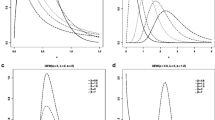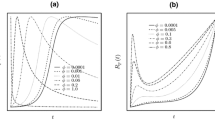Abstract
Estimating equation approaches have been widely used in statistics inference. Important examples of estimating equations are the likelihood equations. Since its introduction by Sir R. A. Fisher almost a century ago, maximum likelihood estimation (MLE) is still the most popular estimation method used for fitting probability distribution to data, including fitting lifetime distributions with censored data. However, MLE may produce substantial bias and even fail to obtain valid confidence intervals when data size is not large enough or there is censoring data. In this paper, based on nonlinear combinations of order statistics, we propose new estimation equation approaches for a class of probability distributions, which are particularly effective for skewed distributions with small sample sizes and censored data. The proposed approaches may possess a number of attractive properties such as consistency, sufficiency and uniqueness. Asymptotic normality of these new estimators is derived. The construction of new estimation equations and their numerical performance under different censored schemes are detailed via Weibull distribution and generalized exponential distribution.
Similar content being viewed by others
Notes
The monotonicity property of \(t\mapsto W_N (t)\) is guaranteed for the examples provided in the paper, hence the approach in the textbook Maritz (1995) is sufficiently general in that cases. However, our theoretical arguments for proving asymptotic normality adapt rapidly to nonmonotonic maps \(t\mapsto W_N (t)\).
In this section, \(c\) and \(C\) are constants that may change from line to line.
References
Brown, B. M. (1985). Grouping problems in distribution-free regression. Australian Journal of Statistics, 27, 123–134.
Csörgő, M., Horváth, L. (1990). On the distribution of \(L_p\) norms of weighted quantile processes. Annales de l’I.H.P., section B, 26, 65–85.
Csörgő, M., Révész, P. (1978). Strong approximations of the quantile process. Annals of Statistics, 6, 882–894.
Csörgő, M., Yu, H. (1997). Estimation of total time on test transforms for stationary observations. Stochastic Processes and their Applications, 68, 229–253.
Dodson, B. (1994). Weibull analysis: with software. Milwaukee: ASQ Quality Press.
Giorgi, G. M. (1999). Income inequality measurement: the statistical approach. In J. Silber (Ed.), Handbook of income inequality measurement (pp. 245–267). Boston: Kluwer.
Gupta, R. D., Kundu, D. (1999). Generalized exponential distributions. Australian and New Zealand Journal of Statistics, 41, 173–188.
Gupta, R. D., Kundu, D. (2001). Generalized exponential distributions: different methods of estimations. Journal of Statistical Computation and Simulation, 69, 315–338.
Gupta, R. D., Kundu, D. (2003). Closeness of gamma and generalized exponential distribution. Communications in Statistics—Theory and Methods, 32, 705–721.
Gupta, R. D., Kundu, D. (2006). On the comparison of Fisher information of the Weibull and GE distributions. Journal of Statistical Planning and Inference, 136, 3130–3144.
Gupta, R. D., Kundu, D. (2007). Generalized exponential distribution: existing results and some recent developments. Journal of Statistical Planning and Inference, 137, 3537–3547.
Hampel, F. R., Rousseeuw, P. J., Ronchetti, E. M., Stahel, W. (1986). Robust statistics: the approach based on influence functions. New York: Wiley Interscience.
Hosking, J. R. M. (1990). L-moments: analysis and estimation of distributions using linear combinations of order statistics. Journal of the Royal Statistical Society B, 52, 105–124.
Hosking, J. R. M. (1995). The use of L-moments in the analysis of censored data. In N. Balakrishnan (Ed.), Recent advances in life-testing and reliability (pp. 545–564). Boca Raton: CRC Press.
Jones, B. L., Zitikis, R. (2003). Empirical estimation of risk measures and related quantities. North American Actuarial Journal, 7, 44–54.
Kundu, D., Gupta, R. D., Manglick, A. (2005). Discriminating between the log-normal and generalized exponential distribution. Journal of Statistical Planning and Inference, 127, 213–227.
Lawless, J. F. (1975). Construction of tolerance bounds for the extreme value and Weibull distributions. Technometrics, 17, 255–261.
Lawless, J. F. (2003). Statistical models and methods for lifetime data (2nd ed., pp. 1691–1696). New York: Wiley.
Maritz, J. S. (1995). Distribution-free statistical methods. London: Chapman& Hall.
Mitra, S., Kundu, D. (2008). Analysis of the left censored data from the generalized exponential distribution. Journal of Statistical Computation and Simulation, 78, 669–679.
Raqab, M. Z. (2002). Inferences for generalized exponential distribution based on record statistics. Journal of Statistical Planning and Inference, 104, 339–350.
Wang, B. X., Yu, K., Jones, M. C. (2010). Inference under progressively type II right censored sampling for certain lifetime distributions. Technometrics, 52, 453–460.
Weerahandi, S. (2004). Generalized inference in repeated measures: exact methods in MANOVA and mixed models. New Jersey: Wiley.
Acknowledgments
The authors thank the Editor, the Associate Editor and referees for constructive comments and suggestions that led to substantial improvements in the paper. Keming Yu is partially supported by NSF grant 11261048 of China. Bing Xing Wang is supported by Foundation of Ministry of Education of China under Grant No. 12YJA910005. Valentin Patilea gratefully acknowledges financial support from the Romanian National Authority for Scientific Research, CNCS-UEFISCDI, project PN-II-ID-PCE-2011-3-0893.
Author information
Authors and Affiliations
Corresponding author
About this article
Cite this article
Yu, K., Wang, B.X. & Patilea, V. New estimating equation approaches with application in lifetime data analysis. Ann Inst Stat Math 65, 589–615 (2013). https://doi.org/10.1007/s10463-012-0385-6
Received:
Revised:
Published:
Issue Date:
DOI: https://doi.org/10.1007/s10463-012-0385-6




